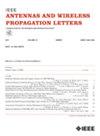A New Self-Decoupling Structure on Coupling Compensating Technique for MIMO Patch Antennas
IF 4.8
2区 计算机科学
Q2 ENGINEERING, ELECTRICAL & ELECTRONIC
引用次数: 0
Abstract
In this letter, an effective self-decoupling solution for multiple-input–multiple-output (MIMO) patch antennas is proposed based on the capacitive and inductive coupling compensating technique. Initially, the coupling principles for the original coupled antenna array are studied, and the decoupling condition for two closely spaced patch antennas in the H-plane is obtained. Subsequently, a concise decoupling element composed of six pairs of shorting pins is developed. Herein, four pairs of shorting pins deployed at the corners of the patches aim to introduce additional inductive coupling to effectively suppress mutual coupling between adjacent antennas, whereas the remaining two pairs of shorting pins, together with the etched slots, are designated to introduce additional capacitive coupling and reduce the cross polarization. To verify the feasibility of the proposed self-decoupling scheme, prototypes of two-element patch antennas are respectively constructed and tested before and after applying the self-decoupling design. Results reveal that, in comparison with the coupled array, the isolation between two self-decoupled elements is improved from 10.5 dB to 17.5 dB at the center frequency of 4.85 GHz with an extremely close edge-to-edge separation of 0.007λ0. Furthermore, owing to the single-layer layout, the overall antenna profile is maintained at a relatively low height of 0.04λ0. Ultimately, the proposed decoupling scheme is also theoretically validated in three-element and E-plane arrays, demonstrating effective isolation enhancement for large-scale compact patch configurations.一种新的MIMO贴片天线耦合补偿自耦结构
本文提出了一种基于电容和电感耦合补偿技术的多输入多输出贴片天线自耦解耦方案。首先对原耦合天线阵的耦合原理进行了研究,得到了h平面内两个紧密间隔贴片天线的去耦条件。在此基础上,建立了由6对短针组成的简洁解耦单元。其中,在贴片的角落部署的四对短引脚旨在引入额外的电感耦合,以有效抑制相邻天线之间的相互耦合,而其余两对短引脚与蚀刻槽一起用于引入额外的电容耦合,以减少交叉极化。为了验证所提出的自解耦方案的可行性,在采用自解耦设计前后分别构建了双元贴片天线样机并进行了测试。结果表明,与耦合阵列相比,在中心频率为4.85 GHz时,两个自解耦元件之间的隔离度从10.5 dB提高到17.5 dB,边沿距离极近,为0.007λ0。此外,由于单层布局,天线整体轮廓保持在相对较低的0.04λ0高度。最后,本文提出的解耦方案在三维和e平面阵列中也得到了理论验证,证明了对大规模紧凑贴片结构的有效隔离增强。
本文章由计算机程序翻译,如有差异,请以英文原文为准。
求助全文
约1分钟内获得全文
求助全文
来源期刊
CiteScore
8.00
自引率
9.50%
发文量
529
审稿时长
1.0 months
期刊介绍:
IEEE Antennas and Wireless Propagation Letters (AWP Letters) is devoted to the rapid electronic publication of short manuscripts in the technical areas of Antennas and Wireless Propagation. These are areas of competence for the IEEE Antennas and Propagation Society (AP-S). AWPL aims to be one of the "fastest" journals among IEEE publications. This means that for papers that are eventually accepted, it is intended that an author may expect his or her paper to appear in IEEE Xplore, on average, around two months after submission.

 求助内容:
求助内容: 应助结果提醒方式:
应助结果提醒方式:


